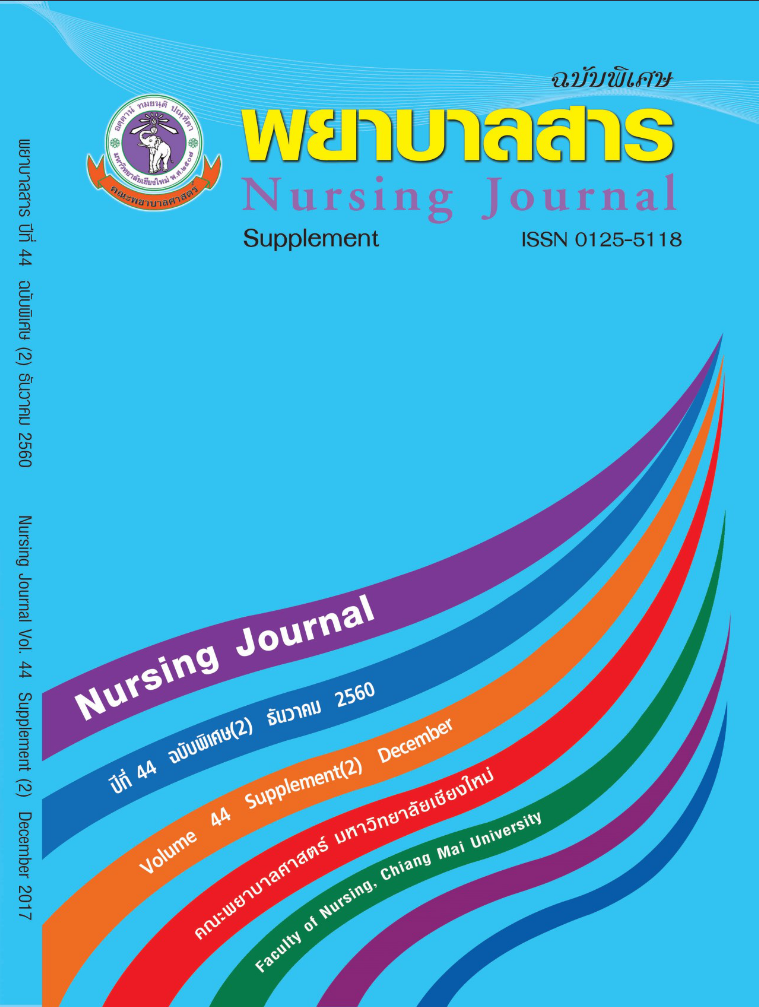Factors Predicting Sleep Quality Among Nursing Students
Keywords:
Sleep habits, Stress, Sleep quality, Nursing studentsAbstract
Sleep quality of nursing students is an indicator of both physical and mental health affecting the quality of learning and graduation success. The purpose of this predictive correlational descriptive study was to determine predictive factors of sleep quality among nursing students such as age, college year, grade point average (GPA), sleep habits and stress. The participants were 217 nursing students of freshman, sophomore, junior, and senior classes of one nursing college from April to May 2017. Proportionate stratified random sampling was used. Data were collected using 1) the sleep habits questionnaire which showed the content validity index of 1, 2) the Suanprung Stress Test (Mahatnirunkul, Pumpaisarnchai & Tapunya, 1997), and 3) the Pittsburgh Sleep Quality Index (Jirapramukpitak & Tanchaiswad, 1997). The last three scales showed the reliability of Cronbach’s alpha efficiency of .70, .96 and .80, respectively. Data were analyzed using descriptive statistics, and enter logistic regression.
Results of the study showed that
- More than half of the samples (66.36 %) had poor sleep quality.
- Age, college year, GPA, sleep habits, and stress were accounted for 27.5% in sleep quality (Nagelkerke R2 = .275). Sleep habits and stress significantly predicted sleep quality (OR = .23; 95% Cl = .09-.57, p<.01 and OR = 2.91; 95% Cl = 1.81-4.67, p<.01 respectively).
The results of this study is useful for educational institution administrators and nursing instructors to promote students to have good sleep quality by means of providing activities to promote good sleep habits, using appropriate relaxing techniques starting in their freshman year as well as monitoring continuously until graduation.
References
ตะวันชัย จิรประมุขพิทักษ์ และวรัญ ตันชัยสวัสดิ์. (2540). ปัญหาคุณภาพการนอนหลับของพยาบาลประจำการ โรงพยาบาลสงขลานครินทร์. วารสารสมาคมจิตแพทย์แห่งประเทศไทย, 42(3), 123-132.
บุญใจ ศรีสถิตนรากูร. (2550). ระเบียบวิธีการวิจัยทางพยาบาลศาสตร์ (พิมพ์ครั้งที่ 4). กรุงเทพฯ: ยูแอนด์ไอ อินเตอร์ มีเดีย.
ผาณิตา ชนะมณี. (2548). คุณลักษณะส่วนบุคคล การรับรู้ภาวะสุขภาพ ความเครียด สุขนิสัยการนอน และคุณภาพการนอนหลับของนักศึกษามหาวิทยาลัยในภาคใต้ (วิทยานิพนธ์พยาบาลศาสตรมหาบัณฑิต สาขาการพยาบาลผู้ใหญ่). มหาวิทยาลัยสงขลานครินทร์.
ผาณิตา ชนะมณี, สุนุตตรา ตะบูนพงศ์, และถนอมศรี อินทนนท์. (2549). คุณภาพการนอนหลับและปัจจัยที่เกี่ยวข้องของนักศึกษามหาวิทยาลัยในภาคใต้. สงขลานครินทร์เวชสาร, 24(3), 163-173.
พิชญ์สินี มงคลสิริ. (2557). การปรับปรุงคุณภาพการนอนหลับของนักศึกษาพยาบาลศาสตร์
วิทยาลัยพยาบาลบรมราชชนนี อุดรธานี. การประชุมใหญ่และนำเสนอผลงานวิชาการระดับชาติ เรื่อง สหวิทยาการ: ความหลากหลายทางวัฒนธรรมสู่ประชาคมอาเซียน. ตรัง: โรงแรมธรรมรินทร์ธนา, 16-29.
วราภา แหลมเพ็ชร. (2544). การนอนหลับและปัจจัยรบกวนการนอนหลับของผู้ป่วยสูงอายุที่เข้ารับการรักษาในโรงพยาบาลแผนกอายุรกรรม (วิทยานิพนธ์พยาบาลศาสตรมหาบัณฑิต สาขาการพยาบาลผู้ใหญ่). มหาวิทยาลัยสงขลานครินทร์.
สุวัฒน์ มหัตนิรันดร์กุล, วนิดา พุ่มไพศาลชัย, และ พิมพ์มาศ ตาปัญญา. (2540). รายงานการวิจัยเรื่องการสร้างแบบวัดความเครียดส่วนปรุง. เชียงใหม่: โรงพยาบาลสวนปรุง.
อินทิรา ปากันทะ. (2550). ปัญหาการนอนหลับและวิธีการแก้ไข. วารสารพยาบาลศาสตร์ มหาวิทยาลัยนเรศวร, 1(2), 31-38.
Alimirzae, R., Azzizadeh, F. M., Abazari, F., & Haghdoost, A. (2014). Prevalence of quality of sleeping and its determinants among Students of Kerman Razi School of nursing and midwifery. Asian Journal of Nursing Education and Research, 4(1), 76-80.
Ban, D. J., & Lee, T. J. (2001). Sleep duration, subjective sleep disturbances and associated factors among university students in Korea. Journal of Korean Medical Science, 16, 475-480.
Benavente, S. B. T., Marques da Silva, R., Higashi, A. B., Guido, L. de A., & Costa, A. L. S. (2014). Influence of stress factors and socio-demographic characteristics on the sleep quality of nursing students. Revista Da Escola De Enfermagem Da U S P, 48(3), 512-518. doi: 10.1590/S0080-623420140000300018
Buboltz, W. C., Brown, F., & Soper, B. (2001). Sleep habits and patterns of college students: A preliminary study. Journal of American College Health, 50(3), 131-135.
Buysse, D. J., Reynolds lll, C. F., Monk, T. H., Berman, S. R., & Kupfer, D. J. (1989). The pitts-burgh sleep quality index: A new instrument for psychiatric practice and research. Psy-chiatry Research, 28, 193-213.
Centers for Disease Control and Prevention [CDC]. (2015). Sleep and sleep disorders. Re-trieved from: https://www.cdc.gov/sleep/about_sleep/index.html
Division of Sleep Medicine at Harvard Medical School. (2008). Sleep and memory. Retrieved from: http://healthysleep.med.harvard.edu/need-sleep/whats-in-it-for-you/memory
Gaultney, J. F. (2010). The prevalence of sleep disorders in college students: Impact on aca-demic performance. Journal of American College Health, 59(2), 91-97.
Gray, E. K., & Watson, D. (2002). General and specific traits of personality and their relation to sleep and academic performance. Journal of Personality, 70(2), 177-206. doi: 10.1111/1467-6494.05002
Howell, A. J., Jahrig, J. C., & Powell, R. A. (2004). Sleep quality, sleep propensity and academic performance. Perceptual and Motor Skills, 99, 525-535.
Hsu, H. C., Chen, T. E., Lee, C. H., Shih, W. M. J., & Lin, M. H. (2014). Exploring the relationship between quality of sleep and learning satisfactions on the nursing college students. Health, 6, 1738-1748.
LeBourgeois, M. K., Giannotti, F., Cortesi, F., Wolfson, A. R., & Harsh, J. (2005). The relation-ship between reported sleep quality and sleep hygiene in Italian and American adoles-cents. Pediatrics, 115(1), 257-265. doi: 10.1542/peds.2004-0815H
Leger, D., Guilleminault, C., Bader, G., Levy, E., & Paillard, M. (2002). Medical and Socio-Professional Impact of Insomnia. Sleep, 25(6), 621-625.
Lund, H. G., Reider, B. D., Whiting, A. B., & Prichard, J. R. (2010). Sleep patterns and predic-tors of disturbed sleep in a large population of college students. Journal of Adolescent Health, 46, 124–132. doi:10.1016/j.jadohealth.2009.06.016
Stepanski, E. J. & Wyatt. J. K. (2003). Use of sleep hygiene in the treatment of insomnia. Sleep Medicine Reviews, 7(3), 215-225. doi:10.1053/smrv.2001.0246
Tsai, L-L. & Li, S-P. (2004). Sleep patterns in college students: Gender and grade differences. Journal of Psychosomatic Research, 56, 231-237. doi:10.1016/S0022-3999(03)00507-5
Tynjälä, J., Kannas, L., Levälahti, E., & Välimaa, R. (1999). Perceived sleep quality and its pre-cursors in adolescents. Health Promotion International, 14(2), 155-166.
Valerio, T. D., Jin Kim, M., & Sexton-Radek, K. (2016). Association of stress, general health, and alcohol use with poor sleep quality among U.S. college students. American Journal of Health Education, 47(1), 17–23.
Welle, P. D., & Graf, H. M. (2011). Effective lifestyle habits and coping strategies for stress tol-erance among college students. American Journal of Health Education, 42(2), 96-105.
Wolfson, A. R. & Carskadon, M. A. (2003). Understanding adolescents’ sleep patterns and school performance: A critical appraisal. Sleep Medical Review, 7(6), 491-506.
doi:10.1053/smrv.2002.025
Downloads
Published
How to Cite
Issue
Section
License
บทความที่ได้รับการตีพิมพ์เป็นลิขสิทธิ์ของวารสารพยาบาลสาร
ข้อความที่ปรากฏในบทความแต่ละเรื่องในวารสารวิชาการเล่มนี้เป็นความคิดเห็นส่วนตัวของผู้เขียนแต่ละท่านไม่เกี่ยวข้องกับมหาวิทยาลัยเชียงใหม่ และคณาจารย์ท่านอื่นๆในมหาวิทยาลัยฯ แต่อย่างใด ความรับผิดชอบองค์ประกอบทั้งหมดของบทความแต่ละเรื่องเป็นของผู้เขียนแต่ละท่าน หากมีความผิดพลาดใด ๆ ผู้เขียนแต่ละท่านจะรับผิดชอบบทความของตนเองแต่ผู้เดียว






